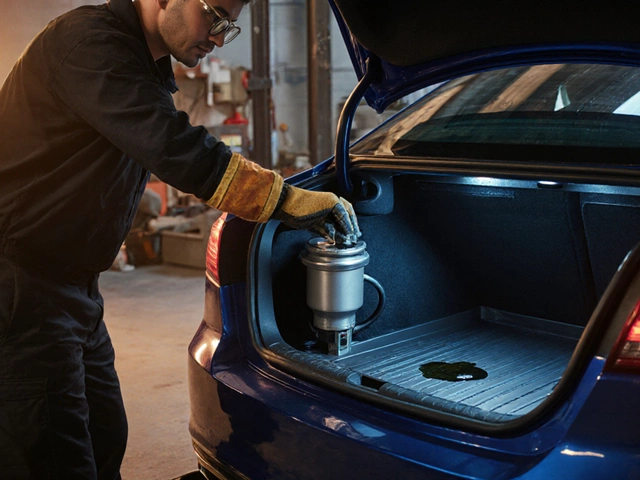There’s a humble yet critical component in your vehicle that holds the power to influence both performance and emissions: the spark plug. Not many motorists spare a thought for these small but mighty components, nestled deep within the engine, quietly doing their job with every cycle.
Spark plugs are tasked with igniting the compressed fuel-air mixture within your engine’s cylinders. This tiny lightning bolt is the spark that starts it all, setting off a chain reaction that powers your journey down the road. While their function appears straightforward, their impact on the entire engine system, including the exhaust, is profound and complex.
When spark plugs are functioning as they should, the engine runs smoothly. However, if they falter, this can lead to poor combustion, increased emissions, and a less-than-efficient ride. For those keen on keeping their vehicular companion in optimal condition, it's crucial to understand how spark plugs affect the exhaust. Let's delve into the connection and uncover ways to ensure both your spark plugs and exhaust are in tip-top shape.
- The Role of Spark Plugs in Your Engine
- Impact of Spark Plugs on Exhaust Emissions
- Signs of Spark Plug Problems
- Maintenance Tips for Spark Plugs
- Benefits of Regular Spark Plug Inspection
The Role of Spark Plugs in Your Engine
Spark plugs are a pivotal player in the orchestra of engine parts, albeit one that's often overshadowed by larger components. Their primary function is deceptively simple: they create the spark that ignites the air-fuel mixture inside each cylinder. Yet, this task holds profound significance for the overall efficiency and power of your vehicle. When a spark plug delivers that burst of electrical energy at precisely the right moment, it ensures smooth operation, optimal power output, and clean emissions. The spark that jumpstarts the engine process is measured in thousandths of a second, a feat achieved billions of times throughout its life. This tiny component must endure extreme conditions, withstanding temperatures around 450 to 870 degrees Celsius without faltering. The timing and quality of the spark are critical; any deviation could lead to wasted fuel and more pollutants in the exhaust system.
The intricacies of spark plug design and material composition are equally fascinating. Modern spark plugs are engineered from advanced materials such as platinum and iridium, known for their durability and high melting points. This construction allows them to last longer and provide a more reliable ignition source over thousands of kilometers. Did you know that an average spark plug fires about 3 million times over its lifespan? Each firing event contributes to the controlled burn of the air-fuel mixture, ensuring the engine operates efficiently and smoothly. A perfect spark leads to near-complete combustion, reducing fuel consumption and emissions. The selection of the right spark plug is paramount. It must match the car's specifications to maintain balance and avoid premature wear or engine knocking.
"Good spark plugs can increase performance and longevity while cutting emissions," says automotive engineer David Wright.This is one reason why regular inspections and replacements of spark plugs are recommended by car manufacturers.
Moreover, spark plugs not only ignite the mixture but also help in pre-determining the combustion process. By influencing the flame propagation, they play a part in how the engine performs under various loads and speeds. The size of the spark and the plug's heat range are designed to meet specific operating conditions. Each engine type demands a particular heat range. A plug that's too hot or too cold can cause pre-ignition or fouling, leading to a host of problems. Vehicle performance and maintenance heavily rely on these small components, which bridge the world of electrical energy and mechanical motion. The spark plug gap, which is critical for the creation of the spark, should be accurately set according to the manufacturer's recommendations. Incorrect gaps can lead to misfires or spark blowout which you’ll notice as a shudder in your ride or a falter in acceleration. By understanding precisely how spark plugs fit into the larger picture, motorists can better appreciate their car's needs and maintain a well-run machine.
Impact of Spark Plugs on Exhaust Emissions
Spark plugs are an integral part of your engine's combustion system, and they have a pivotal influence on the exhaust emissions of a vehicle. Their primary function is to create a spark that ignites the air-fuel mixture in the engine's cylinders, leading to a controlled combustion process. The efficiency of this process determines how thoroughly the fuel is burned, directly impacting the types of gases that are emitted through your exhaust. When spark plugs operate optimally, they ensure complete combustion, which reduces the emission of harmful pollutants such as carbon monoxide, hydrocarbon, and nitrogen oxides. In contrast, worn or faulty spark plugs can lead to incomplete combustion, causing these pollutants to increase significantly, thereby contributing to environmental pollution and potentially even failing emission tests.
The efficiency of spark plugs lies in their ability to handle and execute a precise spark at the right moment. Modern spark plugs are designed to last longer and resist fouling, but like any component, they do wear out over time. As they begin to age, the gap between the electrodes can widen, and their ability to generate a strong spark diminishes. This degradation results in a weaker spark that can misfire under stress, often resulting in incomplete combustion cycles. Unburned fuel then exits the combustion chamber and heads through the exhaust system, where it contributes to higher emission levels of hydrocarbons into the atmosphere. For both the environment and your vehicle's efficiency, keeping an eye on spark plug condition is crucial. Not to mention, a small step like replacing faulty spark plugs can boost fuel efficiency by up to 30%.
"Properly functioning spark plugs are vital not just for engine performance, but for meeting environmental standards. They are the unsung heroes of a clean exhaust system," notes Dr. Emily Turner, a renowned automotive engineer and emissions expert.
In the grand scheme of automotive maintenance, spark plugs seem like a minor player, but they can be the Achilles' heel for maintaining your vehicle’s emission standards. Advances in technology have brought us iridium and platinum spark plugs, which offer longevity and enhanced performance. These types provide a harder surface that resists wear and reduces the likelihood of voltage breakdown in the spark plug itself. With advancements like these, the need for frequent replacement diminishes, yet regular checks remain imperative. A quick inspection could reveal build-up of fuel deposits, an early indicator that your plugs are failing. Such signs should be taken seriously, as outdated plugs are notorious for causing an increase in the carbon footprint of your vehicle.
Interestingly, the condition of your spark plugs can also be used as an indicator of other engine issues. For instance, a plug that is covered with a thick layer of oil residue might suggest problems like valve cover gasket leaks or piston ring issues. Identifying such problems early not only helps in reducing your emissions but can also save you from more expensive repairs down the line. By maintaining healthy spark plugs, you are ensuring your vehicle runs smoothly, consumes fuel efficiently, and keeps the environment a bit cleaner.
| Emissions Type | Effect of Worn Spark Plugs | Optimal Condition |
|---|---|---|
| Carbon Monoxide | Increase due to incomplete combustion | Reduced levels with complete combustion |
| Hydrocarbons | Higher levels due to unburned fuel | Lower emissions with efficient burning |
| Nitrogen Oxides | Increased formation due to engine inefficiency | Minimized with effective ignition timing |
To sum up, ensuring that your spark plugs are in prime condition is a sound strategy for achieving lower exhaust emissions, maintaining engine performance, and protecting the planet. As the component that initiates the combustion process, the spark plug is the unsung steward of engine and environmental health. Even though this small part may go unnoticed by many, its effect on the engine's overall operation and emissions is considerable. Regular checks and timely replacements remain key in harnessing the full potential of spark plugs, ultimately leading to a smoother, more efficient, and environmentally considerate drive.

Signs of Spark Plug Problems
The road of car maintenance is peppered with signs and signals that, when heeded, save you a world of trouble down the line. Among these, spark plugs play a covert role, acting as both culprits and indicators when something's amiss under the hood. The signs of problematic spark plugs don't scream out at you like a red dashboard light, but they do chatter in their own subtle language.
If you've ever turned the ignition only to be met with resistance, you might have thought the issue lay elsewhere. Yet, struggling to start is a classic telltale sign of weary spark plugs. These components are integral in providing the spark needed to ignite the engine; if they aren’t sparking effectively, you might end up standing in the rain, key in hand, hoping the engine will turn over just this once.
Performance hiccups while driving manifest as engine misfires. This occurs when one or more cylinders fail to ignite optimally. Such misfires lead to jerky motion or even stalling, which isn't just an annoyance, but can also be quite dangerous. The root cause could well be faulty spark plugs not delivering the spark uniformly. It's like having a conversation where every other word drops out, making it hard to maintain a steady flow.
The performance of your vehicle is closely intertwined with fuel economy. As spark plugs age or degrade, they become less efficient at igniting the fuel-air mixture. This inefficiency can lead to wasted fuel, translating to more frequent stops at the petrol station. An unexpected hike in fuel consumption is often a quiet nudge from your vehicle, telling you to inspect those spark plugs.
Keep an ear out for unusual noises, too. Knocking or rattling sounds beneath the hood can be traced back to faulty spark plugs. When combustion cycles are inconsistent, they're not just inefficient; they’re noisy as well. These sounds might seem minor, but they signal all is not well inside the engine.
The essence of exhaust isn't only in what goes in but equally in what comes out. A full-bodied scent of gasoline puffing from the exhaust can be traced to unburnt fuel, a clear indication that spark plugs aren't doing their job. Spotting this sign means taking swift action before the issue compounds, affecting emissions and your environmental footprint.
The presence of carbon deposits, indicative of a rich fuel mixture, is another red flag. Examining your spark plugs themselves can reveal this; heavy deposits point to incomplete combustion, which affects not only the exhaust system but overall engine health.
"Spark plugs are pivotal to your motor running smoothly without unexpected hiccups," remarks John Dinkel, former editor of Road & Track, underscoring how critical these components are.
A dash light illuminating the engine warning can often be chalked up to a myriad of issues. Among the first checks any mechanic will perform include examining the spark plugs. These little workhorses are often the culprits when that pesky light comes on, urging you to hunt down the cause before further damage ensues.
Maintenance Tips for Spark Plugs
Maintaining your spark plugs in good condition is crucial to ensuring your vehicle runs efficiently and smoothly. The regular upkeep of these small yet vital components not only prolongs their lifespan but also keeps your exhaust system in check. Start by ensuring that your spark plugs are inspected every 30,000 to 50,000 kilometers. This may seem frequent to some, but early detection of potential problems can prevent costly repairs down the road. Modern vehicles often feature long-life spark plugs, which might tempt you to overlook them. However, even these tend to wear out eventually, impacting engine performance.
During an inspection, look for signs of wear such as carbon buildup, which often manifests as a soot-like substance on the tip of the plug. This can indicate that your engine is either burning too much fuel or running too cool. Additionally, pay attention to melting or blistering, which usually signals excessive heat within the engine. If the plugs appear dusty white, this might be a sign of overheating caused by a too-lean air-fuel mixture. Each of these conditions requires addressing the root cause to ensure the longevity of your spark plugs and the health of your engine overall.
Regular cleaning of spark plugs is also part of good maintenance practice. While scraping the deposits off the plug might seem like a logical move, it's best to use a cleaner that can cut through the carbon without damaging the plug's metal. A wire brush or dedicated plug cleaner tool can be quite handy for this task. Once cleaned, examine the gap between the ground electrode and the center electrode. This gap must remain within the manufacturer’s specifications to ensure a proper spark. If the gap appears inconsistent, you might need a spark plug gap tool to adjust it accordingly.
Sometimes, it's beneficial to replace spark plugs preemptively. Even if they don't display outward signs of wear, replacing them during a routine service can often improve performance, particularly in older cars. Keep in mind, choosing the right spark plugs for your vehicle is imperative. Every engine has specific requirements when it comes to the material and heat range of the plugs used. This ensures optimal combustion and longevity.
"A spark plug is a window into the health of the engine," says renowned mechanic and author Paul Brand. "Reading a spark plug is like reading the heart of the engine."In addition to the basics, understanding this nuanced relationship between components allows car enthusiasts and everyday drivers alike to glean more profound insights into the state of their vehicles.
Don't forget to securely fasten the plug back into the engine once cleaned or replaced. A loose spark plug can lead to engine misfires, poor acceleration, and inefficient fuel consumption. If you're unsure about the torque specifications, consult your vehicle's manual. Improper tightening can damage the thread, adding more unnecessary repair costs. Lastly, always use quality plug wires and replace them if they seem worn or damaged. These wires play a crucial role in conducting electricity from the ignition system to the plugs. Ensuring they're in top shape can prevent issues and optimize vehicle performance.

Benefits of Regular Spark Plug Inspection
In the world of automotive maintenance, regular spark plug inspections are a bit like going to the dentist for a check-up. Sure, it might not be the most exciting task on your car’s maintenance checklist, but it is undeniably crucial for keeping your vehicle healthy and running smoothly. Regular inspections can uncover a myriad of potential issues before they morph into costly repairs. This isn't merely about being preventive; it's also about optimizing your vehicle's performance and ensuring an engine that purrs rather than sputters.
During an inspection, you might find worn electrodes or carbon deposits that suggest the spark plugs are past their prime. Such symptoms can lead to poor combustion, inconsistent starts, and an engine that runs less efficiently. Inefficiencies like these are the culprits behind increased tailpipe emissions and reduced fuel economy. When spark plugs aren't creating a strong spark, the air-fuel mixture might not burn entirely, leading to incomplete combustion and resultant emissions that aren't exactly eco-friendly. By nipping these issues in the bud, you not only help your wallet but also contribute positively to the environment.
Consider this: studies have shown that replacing worn spark plugs can improve vehicle miles per gallon by up to 30%. Imagine getting a third more out of each fuel tank simply by keeping the spark plugs in their best possible condition. It's a small change that can lead to significant savings over time. Additionally, a study noted that vehicles with healthy spark plugs tend to have longer engine life spans due to the reduced strain and wear on engine components.
Now, while a regular inspection is pivotal, it also serves as a point of education for the car owner. It teaches us how these tiny components have such an overarching impact on our vehicles. As the saying goes from the Australian Automobile Association,
"A well-maintained spark plug not only ignites the air-fuel mixture but ignites savings as well."
So, what's the takeaway here? Make inspecting and replacing your spark plugs a regular part of your car maintenance routine. Not only will this help ensure your engine runs smoothly, but it will keep your exhaust emissions at bay and enhance fuel efficiency. Plus, a vehicle that starts on the first turn of the key is just a satisfying experience in itself. By keeping an eye on your spark plugs, you're essentially doing yourself and the environment a big favor. What's not to love about that?




